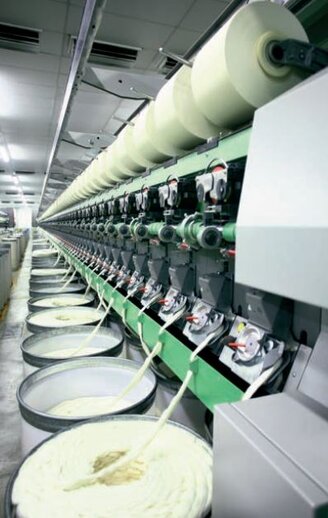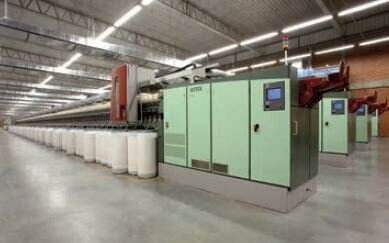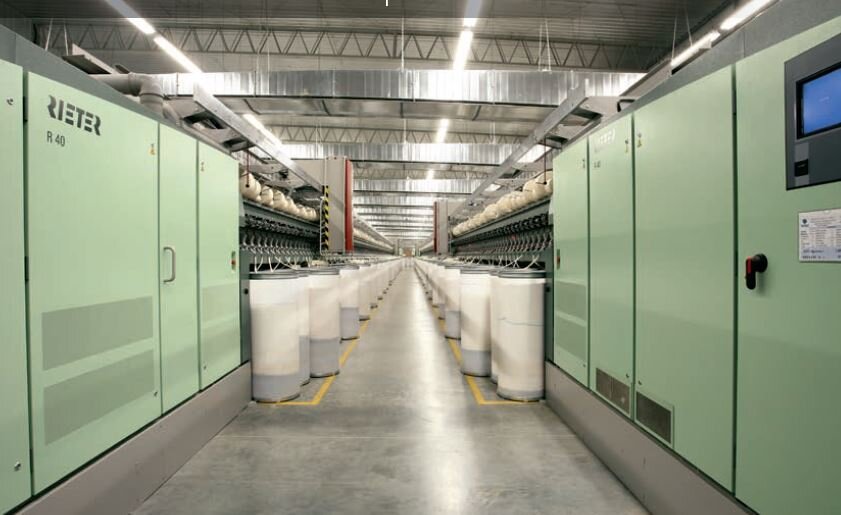Our industry-leading, high-speed industrial robots include high-payload, extended-reach, ultra-maneuverable seven-axis and unique 15-axis dual-arm robots.
Spinning made simple
Textile machine manufacturer Rieter Spinnereimaschinen GmbH uses intelligent drives from Yaskawa
- Industries
- Textile
- Client
- Rieter Spinnereimaschinen GmbH
In the continuous enhancement of its rotor spinning machines, textile machine manufacturer Rieter Spinnereimaschinen GmbH in Ingolstadt is paying particular attention to the drives. The raw material used in rotor spinning, the feed sliver, is drawn into the opening via the feed. Here the sliver is separated into single fibres by the opening roller, which are then spun back into a single yarn via the rotor in the spinning unit. The ratio between the feed and draw-off speeds determines the draft and thus the thickness of the yarn, while its twist is dictated by the rotor speed. From the draw-off, the yarn proceeds to the package spooling stage via the yarn guide. Here, the yarn must be wound according to a very specific pattern in order to ensure a package quality that enables simple further processing or straightforward unwinding of the yarn during subsequent processes.
Inverter drives
Just a few years ago, Rieter’s rotor spinning machine featured only four inverter drives: two for the rotor drives, one for the feed and one for the draw-off. Drives such as those for the opening rollers or the extraction ran fixed to the mains. The package spooling and traverse system was mechanically linked with the draw-off drive via gear boxes and pulleys. Therefore, if the machine was to be used to produce a completely different yarn or packages of different widths, this required adjustments and modifications to the mechanism.
Yet in the face of growing demands for longer machines with a greater number of spinning positions and calls for faster, more flexible machines, the company was forced to investigate new drive concepts. The result is networked drives with intelligent inverter drives that perform part of the control tasks. Today’s machines are equipped with up to 19 inverter drives from Yaskawa T1000 series. The units are linked via CANopen and connected to the machine control system. The draw-off drive serves as the master drive with the feed and rotor running at specific, variable ratios to this master drive along with the package spooling and traverse system. These drives also feature anti-patterning control for the draw-off drive, thus ensuring an optimum package build. The anti-patterning sequence is synchronised in both drives. Especially long machines also feature longitudinal separation in specific parts of the system, such as the feed and draw-off. The mechanically separated machine sections are driven by individual, synchronised inverter drives.
Complex interplay
What makes this system particularly clever is that the complex interplay between the inverters, including the synchronisation of the package spooling, does not require any external control functions. In close cooperation between the European headquarters of Yaskawa in Eschborn and Rieter in Ingolstadt, the firmware of the inverter drives was modified such that the drives only have to be supplied with reference values for the draw-off, yarn twist, package build, etc., and the rest is performed automatically.
Even in the case of a brief power outage – a daily occurrence in many countries where spinning machines are used – a specially developed control system in the Yaskawa T1000 inverters ensures that production continues uninterrupted with unchanged yarn and package properties without intervention on the part of the machine controller. This feature is particularly useful when you consider that an uncontrolled shutdown of the machine results in the breakage of all yarns. Moreover, restarting production of 500 spinning points takes a significant amount of time, even with the aid of four piecing robots.
The Yaskawa inverter drives in the rotor spinning machine also offer Rieter’s customers further benefits. Thanks to their exceptional reliability and durability, drive failures and the resulting production downtimes are practically a thing of the past. In addition, with draw-off speeds increased to a maximum of 350 m/min per spinning point, highest levels of productivity are guaranteed. Improvements have not only been made to the machine’s behaviour in the case of power loss, but also to its flexibility. Switching production to a new yarn now merely requires a few adjustments to the parameters of the machine controller, while the mechanisms remain untouched. Wear parts such as belts have been replaced with electronic systems, which greatly reduces maintenance requirements, raises productivity and increases machine running times. In addition to the resulting cost reductions, the system owner also benefits from lower operating costs since the increased efficiency of the machine brings with it a significant drop in energy use during production.






















